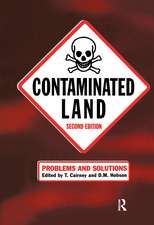Reclaiming Contaminated Land
Autor T. Cairneyen Limba Engleză Paperback – 22 feb 2012
Preț: 386.22 lei
Nou
Puncte Express: 579
Preț estimativ în valută:
73.91€ • 80.26$ • 62.09£
73.91€ • 80.26$ • 62.09£
Carte tipărită la comandă
Livrare economică 23 aprilie-07 mai
Preluare comenzi: 021 569.72.76
Specificații
ISBN-13: 9789401165068
ISBN-10: 9401165068
Pagini: 276
Ilustrații: XII, 260 p. 29 illus.
Dimensiuni: 152 x 229 x 14 mm
Greutate: 0.37 kg
Ediția:Softcover reprint of the original 1st ed. 1987
Editura: SPRINGER NETHERLANDS
Colecția Springer
Locul publicării:Dordrecht, Netherlands
ISBN-10: 9401165068
Pagini: 276
Ilustrații: XII, 260 p. 29 illus.
Dimensiuni: 152 x 229 x 14 mm
Greutate: 0.37 kg
Ediția:Softcover reprint of the original 1st ed. 1987
Editura: SPRINGER NETHERLANDS
Colecția Springer
Locul publicării:Dordrecht, Netherlands
Public țintă
ResearchCuprins
1 Recognition of the problem.- 1.1 Introduction.- 1.2 National response to contaminated land in the UK.- 1.3 National response to contaminated land in Europe and North America.- References.- 2 Types of contaminated land.- 2.1 Introduction.- 2.2 Transportation of contamination.- 2.3 Main sources of land contamination.- 2.4 Conclusions.- References.- 3 Main types of contaminants.- 3.1 Introduction.- 3.2 Metallic contaminants.- 3.3 Inorganic contaminants.- 3.4 Organic contaminants.- 3.5 Asbestos.- 3.6 Combustible materials.- 3.7 Gases.- 3.8 Other contaminants.- References.- 4 Appropriate site investigations.- 4.1 Introduction.- 4.2 Recognition that an investigation is needed and establishment of the basis for that investigation.- 4.3 Design of site sampling/analytical programme.- 4.4 On-site sampling, observation and testing.- 4.5 Analysis of material taken from the site.- 4.6 Interpretation of analytical data.- References.- 5 Available reclamation methods.- 5.1 Introduction.- 5.2 The land use option.- 5.3 General considerations.- 5.4 The options.- 5.5 Excavation.- 5.6 Soil treatment after excavation.- 5.7 In-situ treatment.- 5.8 Macro-encapsulation/isolation.- 5.9 Covering systems.- 5.10 Execution of reclamation works.- 5.11 Monitoring and evaluation of performance.- 5.12 Guidance available.- References.- 6 Soil cover reclamations.- 6.1 Introduction.- 6.2 Performance requirements for soil cover reclamations.- 6.3 The contaminant problem.- 6.4 Pathways for contaminant migration.- 6.5 Groundwater and soil moisture movements.- 6.6 Choice of soil cover materials.- 6.7 The design of soil cover reclamations.- 6.8 Summary.- References.- 7 Long-term monitoring of reclaimed sites.- 7.1. Introduction.- 7.2 Established precedents for monitoring.- 7.3 Questions on the long-term effectiveness of reclamation options.- 7.4 Monitoring systems and methods.- 7.5 Organization control of monitoring.- 7.6 Summary.- References.- 8 Safety in site reclamation.- 8.1 Introduction.- 8.2 Nature of hazards.- 8.3 Protection against hazards.- 8.4 Safety procedures.- 8.5 Conclusions.- 8.6 Appendix: environmental health and safety guide for construction site staff (an example).- References.- 9 Policy, planning and financial issues.- 9.1 Introduction.- 9.2 Controlling the development of contaminated land.- 9.3 Land-use planning and control.- 9.4 Public health legislation and development control.- 9.5 Financial resources.- References.- 10 Landscaping and vegetating reclaimed sites.- 10.1 Introduction.- 10.2 Requirements of plants.- 10.3 Physical support for plants.- 10.4 Compaction.- 10.5 Water supply and storage.- 10.6 Plant nutrients.- 10.7 Grassland establishment.- 10.8 Grass seed mixtures.- 10.9 Grass cutting.- 10.10 Wild species.- 10.11 Trees and shrubs.- 10.12 Timing.- 10.13 Plant and soil interactions.- 10.14 Conclusions.- References.- 11 Hazards from methane (and carbon dioxide).- 11.1 Introduction.- 11.2 Relevant gases and their principal characteristics.- 11.3 Gas flow in and from landfill sites.- 11.4 Gas measurement.- 11.5 Gas control measures.- 11.6 Hazards in buildings.- 11.7 Effects on plants.- Acknowledgement.- References.






